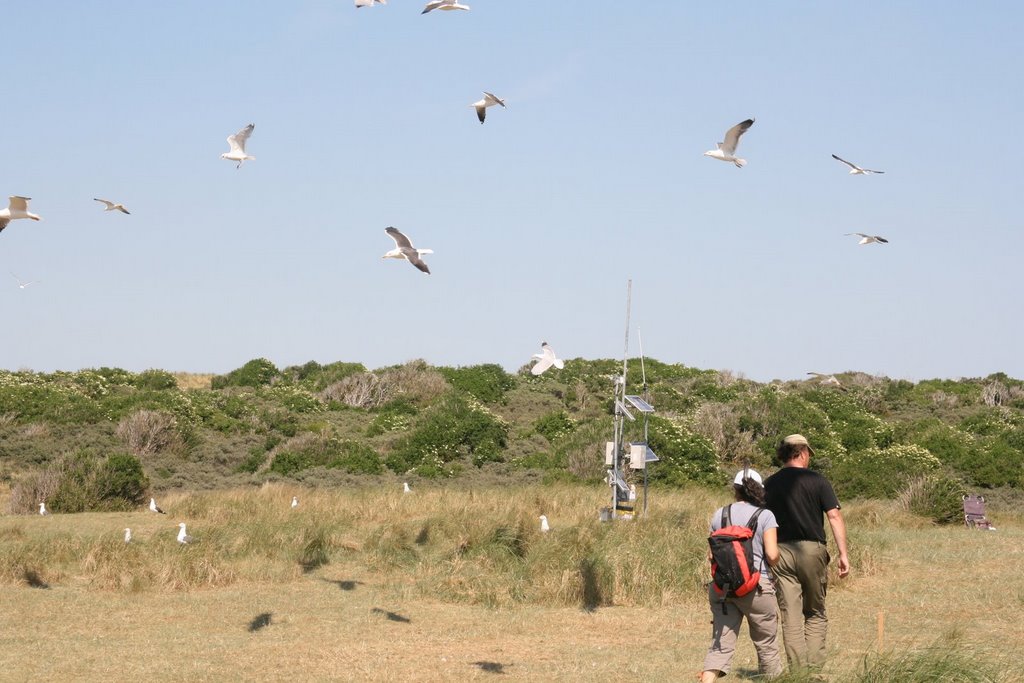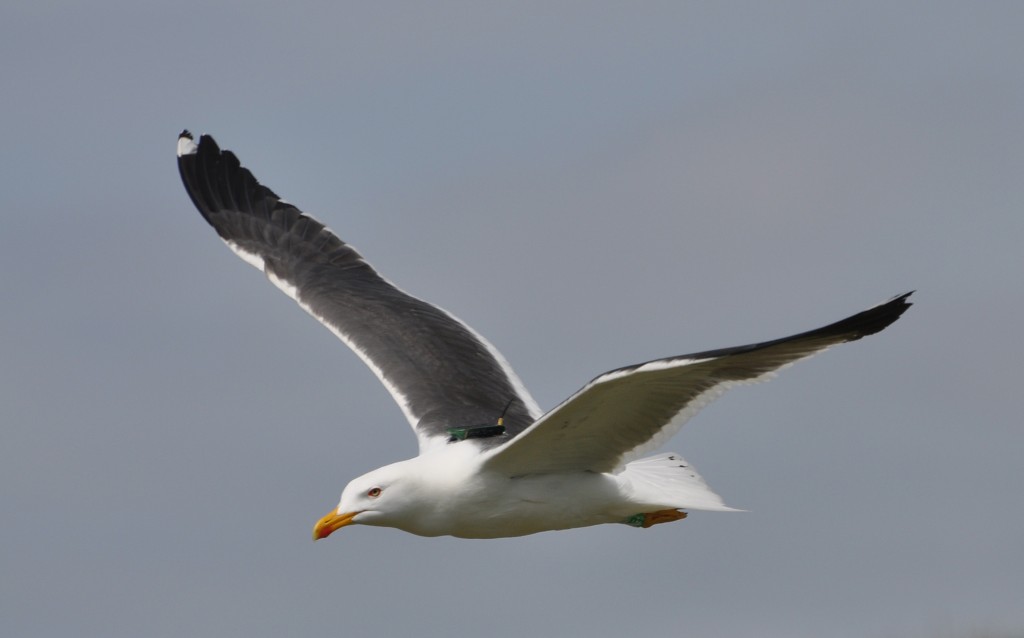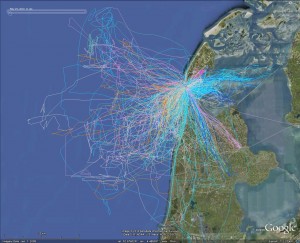Species: Lesser Black-backed Gull
Since 2008, we have been tracking adult Lesser Black-backed Gulls (Larus fuscus) breeding in the Kelderhuispolder on Texel, a Wadden Island in the Netherlands (53°00’N, 04°43’E). Within the area, approximately 11,500 pairs of Lesser Black-backed Gulls and approximately 5000 pairs of Herring Gulls (Larus argentatus) are breeding.
The breeding ecology in this colony has been studied since 2006. Previous work in this colony has revealed that birds rely on a variety of food resources during the breeding season including marine prey, fishery discards, marine mammals, terrestrial mammals, arthropods and refuse.


The aim of this study is to quantify the foraging movements, time budgets and habitat preferences of these birds. Using this information we can conduct comparative analysis of these aspects between individuals, years, genders, breeding phases and migration. We also aim to study the energetic cost of foraging movements by incorporating information on flight strategy selection. In the future we may be able to link these characteristics to life history traits and fitness.

Preliminary results have revealed that foraging trips last several hours on average but may even last over 36 hours. Birds leave the colony at all times of the day and night. Individuals vary in their foraging area preferences and foraging habitats include the North Sea (SW of Texel), deeper parts of the Wadden Sea, coastal areas and the mainland. Birds that spend most of their time foraging in the North Sea, often rest at sea floating with tidal currents. These resting bouts may sometimes last up to 6 hours. Due to the accuracy of the measurements and the high temporal resolution (measurements every 10 minutes to every 3 seconds), individuals are occasionally observed foraging in the same agricultural fields at the same time. These individuals all migrate in the winter, and can move around quite a bit between diverse stopovers, with their furthest winter destinations (per individual) in the UK, France, Spain, Mauritania and Guinea-Bissau. At times, we hear about their distant whereabouts via avid color ring readers, before they return the colony. This study is running in parallel to a herring gull tracking study in the same colony.
In the breeding season of 2021 the following birds can be followed via the interactive maps. Both logger number and color ring code are provided as well as the year the bird was tagged:
2012: 757 FARA (in UK)
2016: 5416 MBAD
2017: 5473 MASF 5588 MBBC 5593 FBBU
2018: 5594 MBBP 5599 MBBX 5601 FBCK 5603 MBBU 5687 MBBS 5693 MBBL 5694 MBBN
2019: 5697 MBCU 5698 MBCV 5699 MBCW 5700 MBCW 5702 FBDV 5704 FBDZ 5705 MBDN
2020: 5592 MBFN 5593 MBFP 5597 MBFV 5995 MBFR 5996 MBFU 5998 MBFX 5999 MBDC
2021: 7045 FBHW 7046 FBHX 7047 MBJF 7048 FBHZ 7050 MBJH 7055 MBJJ 7056 MBJK 7058 FBJA 7059 FBJB 7063 MBJL
Related publications
Shamoun-Baranes J, Burant JB, van Loon EE, Bouten W, Camphuysen CJ, 2017. Short distance migrants travel as far as long distance migrants in lesser black-backed gulls Larus fuscus. Journal of Avian Biology 48:49-57. doi: 10.1111/jav.01229.
Shamoun-Baranes J, Bouten W, van Loon EE, Meijer C, Camphuysen CJ, 2016. Flap or soar? How a flight generalist responds to its aerial environment. Philosophical Transactions of the Royal Society B: Biological Sciences 371. doi: 10.1098/rstb.2015.0395.
Camphuysen CJ, Shamoun-Baranes J, van Loon EE, Bouten W, 2015. Sexually distinct foraging strategies in an omnivorous seabird. Marine Biology:1-12. doi:10.1007/s00227-015-2678-9
Tyson C, Shamoun-Baranes J, Van Loon EE, Camphuysen K, Hintzen NT. 2015. Individual specialization on fishery discards by lesser black-backed gulls (Larus fuscus). ICES Journal of Marine Science. doi:10.1093/icesjms/fsv021
Camphuysen CJ., Shamoun-Baranes J., Bouten W., Garthe S. 2012 Identifying ecologically important marine areas for seabirds using behavioural information in combination with distribution patterns. Biological Conservation 156, 22-29. (doi: 10.1016/j.biocon.2011.12.024).
Shamoun-Baranes J, Bouten W, Camphuysen CJ, Baaij E, 2011. Riding the tide: intriguing observations of gulls resting at sea during breeding. Ibis 153: 411-415.
Shamoun-Baranes J, van Loon EE, Purves RS, Speckmann B, Weiskopf D, Camphuysen CJ, 2011. Analysis and visualization of animal movement. Biology Letters doi:10.1098/rsbl.2011.0764
Camphuysen CJ, de Boer P, Bouten W, Gronert A, Shamoun-Baranes J, 2010. Mammalian prey in Laridae: increased predation pressure on mammal populations expected. Lutra 53:5 – 20
Contact persons, funders and participants
Kees Camphuysen kees.camphuysen@nioz.nl Koninklijk Nederlands Instituut voor Onderzoek der Zee / Royal Netherlands Institute for Sea Research (NIOZ)
Judy Shamoun-Baranes shamoun@uva.nl University of Amsterdam Institute for Biodiversity and Ecosystem Dynamics / Instituut voor Biodiversiteit en Ecosysteem Dynamica (IBED)

